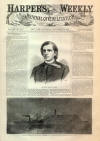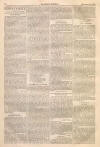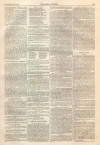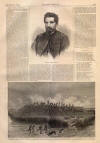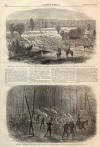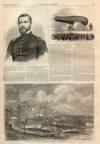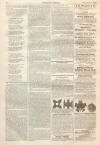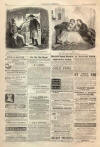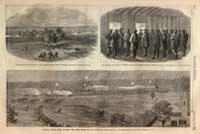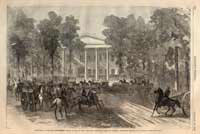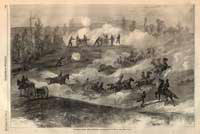One Hundred and Forty Eighth Pennsylvania at Petersburg
|
|
This Site:
|
NOVEMBER 19, 1864.] HARPER'S WEEKLY. 741 CAPTAIN JERRY Z. BROWN.THE VIRGINIA CAMPAIGN.ON this and the preceding page, and on page 748, We engrave illustrations of recent events in the Virginia Campaign. An incident of unusual interest, though not important in its military bearings, was the capture of one of the rebel forts in front of Petersburg on the night of October 27, of which we give an illustration on this page, together with a portrait of Captain J. Z. BROWN, who took a prominent part in the assault. The Second and Third Divisions of the Second Corps, under EGAN and MOTT, were engaged in the movement against the Southside Railroad, and only MILE'S Division was left to guard the intrenchments of the Second Corps. In the course of the day the enemy in front had also been greatly weakened to resist our columns moving on his right flank. In the evening MILES ordered a reconnoissance to discover the force in his immediate front. For this purpose one hundred volunteers were solicited from the One Hundred and Forty-eighth Pennsylvania Volunteers. Besides Captain BROWN, four officers also volunteered : Lieutenants P. D. SPANGLE, ALEXANDER GIBB, J. F. BENNER, and Captain H. D. PRICE. Forming in a trench leading from our picket line to the rebel fort in front, and armed with Spencer's seven shooters, they advanced over a space of two hundred and fifty yards against the fort, which was garrisoned by the Forty-sixth Virginia. The garrison was surprised, and our men advancing in front and on both flanks entered, and after a sharp skirmish took possession, capturing four commissioned officers, among whom was a nephew of Governor HENRY A. WISE. Captain PRICE was the first to enter the fort and was immediately afterward shot. We regret very much that it is impossible for us to give a portrait of Captain PRICE, a gallant officer, who entered the service originally as a private, and rose step by step from a Sergeant to First Lieutenant, and finally to a Captain's rank. He was a son of the Reverend Mr. PRICE, an Episcopal clergyman of Pottstown, Pennsylvania. The fort captured was in our possession half an hour when it was abandoned, on the arrival of fresh troops from other portions of the rebel line. It is impossible to say what advantages might have been gained by our troops if there had been a strong force on the ground ready to support and follow up this daring and successful assault. The illustrations on page 748 relate to the operations of the Second and Fifth Corps, October 27. It will be remembered that in the advance against the enemy's right the Ninth Corps served as a pivot, the Fifth and Second taking more circuitous routes to the left. The Second Corps starting at half past 3 A.M., from a point in the vicinity of the Fifth Corps on the Weldon Road, advanced along the Vaughan Road, and crossing Hatcher's Run, struck for the Boydton plank road, up which they advanced with the intention of turning the enemy's extreme right. The sketch which we engrave of Armstrong's Mills shows the rebel works taken by the Second Corps in the morning. These works were on Hatcher's Run. It was at this point that the Fifth Corps came up, when the Second advanced, as already stated, toward the Boydton Road. The Fifth were to advance up the Run and connect with the right of the Second, but failing to do so on account of an imperfect knowledge of the country, a gap was left between the two columns, which, although it led to no serious reverse, yet gave the ene- my so decided an advantage as to frustrate the main design of the movement. General CRAWFORD, although he failed to connect with the Second Corps, succeeded in capturing two or three hundred prisoners, including four officers, who were during the night conducted to the rear. This was difficult to accomplish, as the night was very dark, and the way led through dense woods and undergrowth, and the enemy, moreover, was in close proximity. Not a prisoner escaped, orders having been given to shoot the first man who stepped out of rank. The escape of a single man to the enemy would have resulted in their becoming acquainted with our movements. General CRAWFORD headed the column in person, picking his way along the bewildering roads by means of a compass. We can not dismiss the operations on the left without alluding to the brilliant conduct of General EGAN'S division of the Second Corps. To understand the operations of this corps we must remember that it left the Vaughan Road before crossing Hatcher's Run, passing over to the Duncur Road, further west. Crossing on this road southward, it then advanced westward, and striking the Boydton Road again turned north up that road toward the Run. EGAN, who was in the advance, was about to cross, having already captured a line of works on the south bank, when MOTT'S Division, at his right, was attacked and pushed back. This left EGAN'S Division entirely exposed in that direction. His left was protected by GREGG'S cavalry. He altered his line, forming a square, and thus protecting flank and rear stood the brunt of three successive charges. These assaults were not only repulsed with severe loss to the enemy, but each repulse was followed by a counter charge. EGAN succeeded in capturing nearly a thousand prisoners. MOTT'S Division was reformed, and also captured several hundred prisoners. Turning now to page 740, we have there three illustrations which relate to operations north of the James. One of these is a view of the Confederate iron-clads on the James River below Chaffin's Bluff, on the left of BUTLER'S army. Two miles below the Bluff, at the Boulare House and at Signal Hill, two Federal batteries have lately been posted. On the 22d of October a sharp artillery duel took place between these and the rebel gun-boats, the latter consisting of the Virginia, Richmond, Fredericksburg, Hampton, and Drewry. The Drewry was struck by a shell, which blew up a gun-carriage and wounded five men. The Fredericksburg had her smoke-stack destroyed and six men wounded. The gun-boats finally retired out of range. The remaining sketches on the page relate to the movement of BUTLER'S army on the 27th, and especially to the operations of the Tenth Corps on and beyond the Darbytown Road. The forenoon was occupied in skirmishing. At noon the advance was ordered, and the enemy was driven inside of his intrenchments, from which he kept up a severe fire all along the line. Our men lay up close to the enemy's works and returned his fire, but without much effect, while suffering many casualties themselves. The First Connecticut Battery, Captain CLINTON, replied to a battery of the enemy's by shelling the woods and the rebel works in front. The action is represented in the sketch as it appeared from the Johnson House, from the windows of which General BUTLER and his staff witnessed the battle. This group of officers is given in another sketch on the same page. AN APPEAL. IT would not cost you much, dear, To linger in the shade, While our gay companions wander Up and down the woodland glade : Let the red fern droop around us, And the dead leaves flutter down, Our hearts are fresh and green, dear, Though the forest's scorch'd and brown.
It would not cost you much, dear, To let me see your hand Ungloved—though well I know it For the fairest in the land : And those dainty little fingers
For an instant might I hold;
To me, 'twere gain untold !
It would not cost you much, dear, To hear me whisper low A secret I discovered Not quite a week ago. Would you promise, having told you, That I never need repent? Ah ! you guess it! No reply ? But your silence gives Consent! CAPTURE OF REBEL FORT IN FRONT OF PETERSBURG BY THE ONE HUNDRED AND FORTY-EIGHTH PENNSYLVANIA, OCTOBER 27, 1864.-[SKETCHED BY A. W. WARREN.]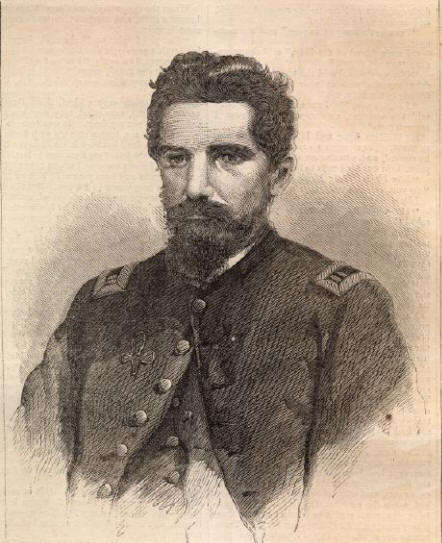 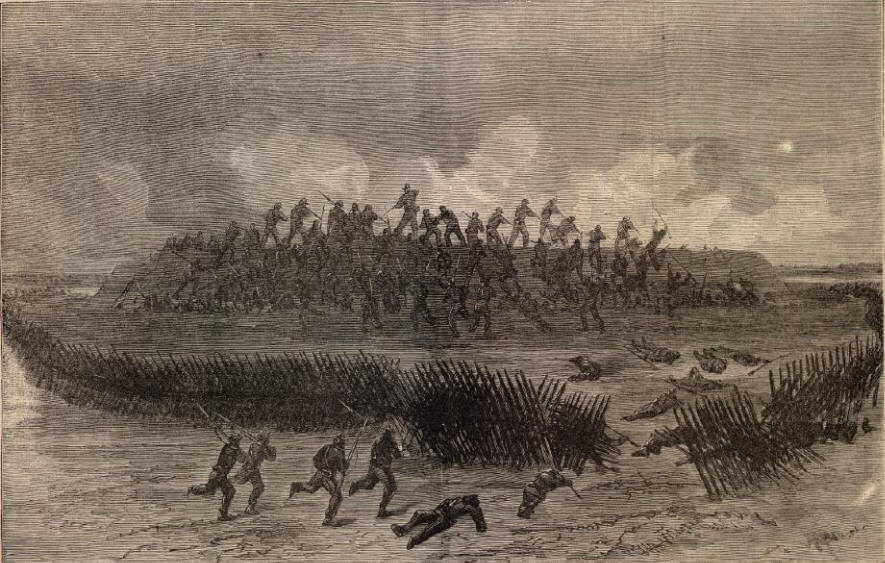 |
||||||||||||||||||||||
|
|
||
|
|
Site Copyright 2003-2018 Son of the South. For Questions or comments about this collection, contact paul@sonofthesouth.net |
|
|
Are you Scared and Confused? Read My Snake Story, a story of hope and encouragement, to help you face your fears. |
||
